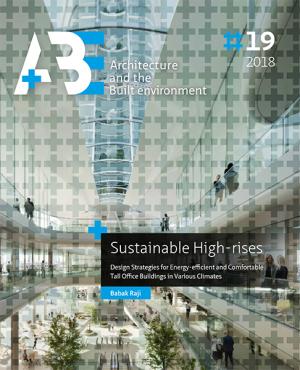Hosted by
Sustainable High-rises: Design Strategies for Energy-efficient and Comfortable Tall Office Buildings in Various Climates
Synopsis
With the aim to limit the number of ineffective designs, this dissertation has investigated the impact of architectural design strategies on improving the energy performance of and thermal comfort in high-rise office buildings in temperate, sub-tropical and tropical climates. As the starting-point of this research, a comparative study between twelve high-rise office buildings in three climate groups was conducted. For each climate group, three sustainable high-rises were selected and one typical high-rise design as a reference. The effectiveness of architectural design strategies was compared between the two categories of buildings (high-performance versus low-performance) concerning their potential impact on heating, cooling, lighting and ventilation loads. Certain architectural design strategies were found to be major determinants of energy performance in high-rise buildings. These can be classified under the categories of geometric factors, envelope strategies, natural ventilation strategies, and greenery systems. To quantify the extent to which these architectural design strategies affect energy use and thermal comfort of tall office buildings, simulation studies were carried out.
To quantify the impact of geometric factors on the energy efficiency of high-rise office buildings, performance-based simulations were carried out for 12 plan shapes, 7 plan depths, 4 building orientations and discrete values for the window-to-wall ratio (WWR). The results of the total annual energy consumption (and different energy end-uses) were used to define the most and least efficient solutions. The optimal design solution is the one that minimises, on an annual basis, the sum of the energy use for heating, cooling, electric lighting and fans. The percentile difference - a deviation in the total energy use - between the most and least efficient design options showed the extent to which geometric factors can affect the energy use of the building. It was found that geometric factors could influence the energy use up to 32%. Furthermore, the recommended design options were classified according to their degree of energy performance for each of the climates.
The second group of strategies is related to the envelope design. To quantify their degree of influence, an existing tall office building was selected as a typical high-rise design for each of the climates and the energy use prior and after refurbishment was compared through computer simulations with DesignBuilder. The 21-storey EWI building in Delft, the Netherlands, is selected as the representative for the temperate climate and the 65-storey KOMTAR tower in George Town, Malaysia, for the tropical climate. As part of a sensitivity analysis, energy performance simulations defined façade parameters with higher impact on building energy consumption. A large number of computer simulations were run to evaluate the energy-saving potential of various envelope measures, as well as their combinations. The results showed which set of envelope measures suits each climate type best. Furthermore, it was found that the right combination of envelope strategies could reduce the total energy use of a conventional tall office building by around 42% in temperate climates and around 36% in tropical climates.
One other important difference between conventional and sustainable tall buildings is related to the application of natural ventilation. In this regard, the potential use of different natural ventilation strategies to reduce the energy demand for cooling and mechanical ventilation in high-rise buildings was investigated by using the same validated base models. The results showed that for a naturally ventilated tall office building in the temperate climate on average only 4% of the occupancy hours a supplementary air-conditioning system might be needed for providing thermal comfort during summer. For the tropical climate, the average percentage of discomfort hours (when air-conditioning is required to keep the indoor air temperature within the comfort limits) was around 16% of the occupancy hours during one year. In both climates, natural ventilation strategies could meet the minimum fresh air requirements needed for an office space for almost the entire period of occupancy hours; 96% in temperate climates and 98% in tropical climates.
The last important strategy that is becoming an integrated part of sustainable tall buildings is the use of greenery systems. The effects of greenery systems on the energy-efficiency, thermal comfort and indoor air quality of buildings were investigated by conducting a thorough literature review on five greenery concepts, including the green roof (GR), green wall (GW), green balcony (GB), sky garden (SG) and indoor sky garden (ISG). It was found that greenery systems have a limited impact for reducing the energy use of high-performance buildings. The maximum efficiency of greenery systems was reported during summer and for places with higher solar radiation and when integrated into buildings that have no solar control systems. However, other large-scale benefits for the urban environment (mitigation of CO2 concentration) and building residents (increased productivity and higher well-being) could justify the application of greenery systems as an essential sustainability feature for the design of tall office buildings.
To sum up, the architectural design is a determinant contributor to the performance of buildings and the comfort of occupants. The findings of this research were used to point out climate specific design strategies for tall office buildings in temperate and tropical climates. At the end of dissertation, a proposed model of an energy-efficient and comfortable high-rise office building for each of the investigated climates was illustrated. It is expected that the discussions and recommendations provided in this dissertation could form an acceptable starting point for improvements to tall building design and could be of assistance to make energy-wise decisions during the design process.

